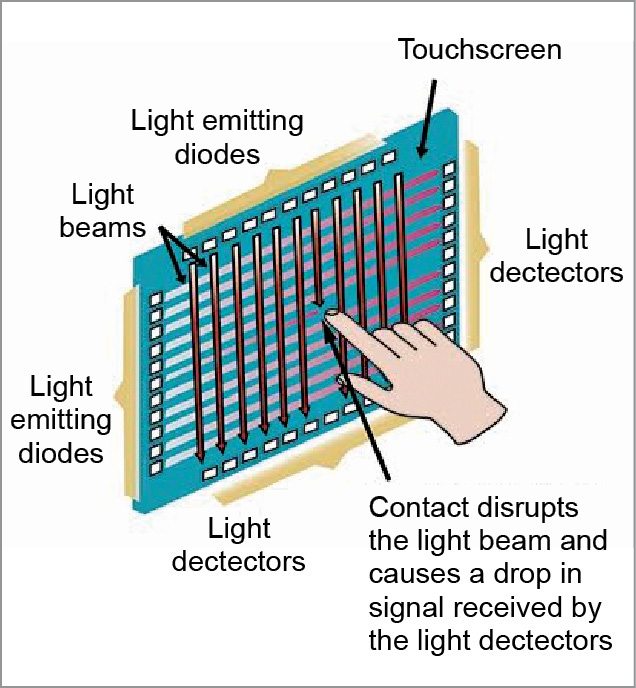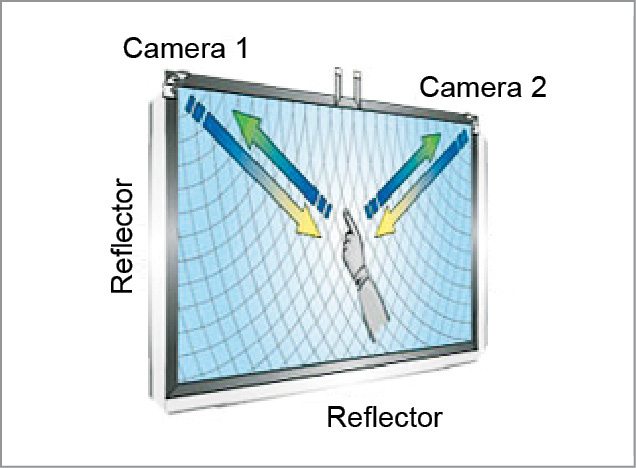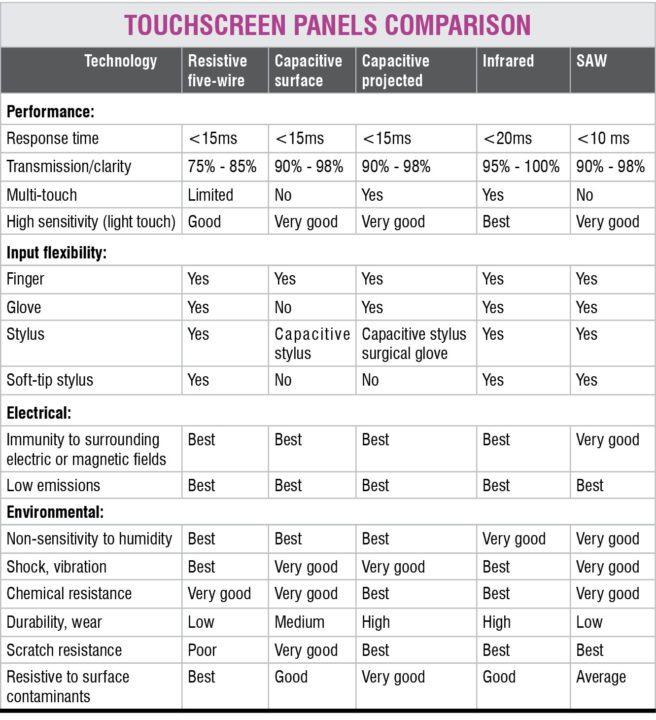IR grid technology. Another type of mostly used touch panels are the IR touch panels (ITPs). IR technology consists of IR LEDs and light sensors that are placed on the perimeter of the bezel. LEDs transmit beams of light that run side by side to the assigned light sensor and create a light grid. If anything disrupts the light or reduces it, a touch point is registered by the controller.

Performance is sensitive to water, snow, rain and ambient light interference. The screen could malfunction due to build up of dust, oil or grease. Cost is relatively high as compared to other touch technologies.
SAW touchscreen. A SAW is a structure-borne sound wave that spreads across a surface in a planar manner, that is, in two dimensions. The receiving transducer locates the touch point and sends this data to the controller.
SAW touchscreens have excellent image clarity, so can display high-detail graphics. These can be activated by a finger, gloved hand or soft-tip stylus.
However, SAW panels are the most expensive of the three liquids, and any contact with something hard like a pen or finger nail can cause a false trigger. Solid contaminants on the screen can create non-touch areas, until removed.
Optical touchscreens. This is a relatively-modern development in touchscreen technology, which uses two line-scanning cameras located at the corners of the screen. IR backlights are placed in the camera’s field-of-view on the other side of the screen.

This technology is growing in popularity due to its scalability, versatility and affordability, especially for bigger units. It permits 100 per cent light transmission and requires only one calibration.
Near-field imaging touchscreens. This is one of the newest technologies and consists of two touchscreens. When the finger, glove or any other conductive stylus comes into contact with the sensor, electrostatic field is disturbed. It is an extremely-durable screen that is suited for use in industrial control systems and other harsh environments.

Factors to consider for buying touchscreen panels
Selection of a touchscreen panel is basically determined by the application and expected users. A panel for a classroom (teacher and students) will have different qualitative requirements when compared with that of a touchscreen controller panel for an industrial setup. In these two setups, size, response time and environment cost will have bearing on the selection of the touchscreen.
Important performance specifications to be considered when buying touchscreen displays include:
Touch type. Touchscreens discussed above have distinct advantages and disadvantages. Selection is therefore a compromise, by adjusting pluses against minuses. Projected capacitive type is ideal for harsh, industrial and outdoor applications. IR type will not fit the bill for such applications. If clarity of a picture is important, then IR will be a preferable option, higher cost notwithstanding.
Screen size. Touchscreens are available in small, medium and large sizes. Touchscreen monitors are usually 8.9cm to 1.3m (3.5-inch to 52-inch) in size. Most common sizes are 38.1cm to 48.2cm (15-inch to 19-inch) and 81.2cm to 1.1m (32-inch to 42-inch) for large control rooms. Large displays up to 2.5m (100-inch) are also available. Aspect ratio (4:3 or 16:9) should also be considered.
Accuracy of touch. This is the ability to provide reliable touch performance in devices when the touch sensor is subjected to large amounts of noise from sources such as displays and chargers. You must be able to accurately select targets on touchscreens and avoid accidental selection of adjacent targets.
Touchscreen resolution. It refers to resolution or the number of touch-active points on the touchscreen. It affects the level of pointing precision and selection errors. Therefore a higher-resolution screen provides additional touch points, allowing greater pointing.
Another resolution (pixel density) to be considered is that of the display, which can be HD, full-HD and so on.
Response time. The shorter the time between a touch and the response, the better you would feel about the touch system. It is specified in milliseconds (ms). Latency is typically 75ms to 100ms. Studies have shown that humans need less than 10ms for comfort. SAW touchscreens have the shortest response time of around 10ms, whereas IR has a higher response time of around 20ms.
Transmission/clarity. Touchscreens are normally on top of the display, so there is loss of light and affect on clarity of the image. But IR touchscreens have no overlay, therefore transmission is 95 per cent to 100 per cent, and clarity is the best. Resistive type has the lowest rating for this attribute.
Life expectancy. Due to continuous use of the screen, degradation in performance is expected. Life of IR type is around five years, whereas capacitive type has a short life of around two years only.
Resistance to scratch, chemical, dust and grease. The top-most layer of the screen must be tough enough to resist scratches. The assembly must have proper sealing to prevent ingress of water and chemicals.
Ergonomics. The design of touchscreen interfaces must reflect on cognitive psychology and humans. This deals with placement of touch points, their size, sequence, colour combination and overall appearance.
Environment. Selection of a touchscreen panel is also based on its deployment. If it is in open and harsh conditions, then selection will be based on the type that can withstand dust, temperature, moisture, etc.
Nidhi Kathuria is a senior application engineer at EFY Labs, New Delhi










